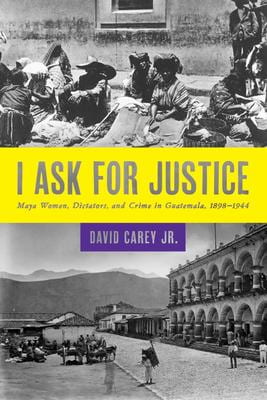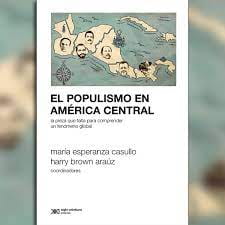A Review of I Ask for Justice: Maya Women, Dictators, and Crime in Guatemala, 1898–1944
Women and the Court: Nation-Building in Guatemala

I Ask for Justice: Maya Women, Dictators, and Crime in Guatemala, 1898–1944 By David Carey, Jr. University of Texas Press, 2013
On May 10, 2013, General Efraín Ríos Montt sat before a packed courtroom in Guatemala City listening to a three-judge panel convict him of genocide and crimes against humanity. The conviction, which mandated an 80-year prison sentence for the octogenarian, followed five weeks of hearings that included testimony by more than 90 survivors from the Ixil region of the department of El Quiché, experts from a range of academic fields, and military officials. The genocide case against Efraín Ríos Montt and Mauricio Rodríguez Sánchez (who was found not guilty) occurred because survivors appealed for justice by petitioning Guatemala’s courts. Citizens turned to their courts despite decades of impunity enjoyed by the perpetrators of the violence—military and paramilitary forces which the United Nations Commission for Historical Clarification declared responsible for 93 percent of the deaths and disappearances of 200,000 people.
Because of the gendered nature of Guatemala’s genocide, Ixil women’s testimony and presence during the hearings defined the legal process. Photographers from newspapers, human rights groups and communities posted hundreds of images of Ixil women wearing intricately woven huipiles as they performed ceremonies outside the courtroom, sat listening intently to simultaneous Ixil translations of the hearings through red or white headphones, and testified to the violence they suffered. Twelve Ixil women, who appeared before the court often with their faces and heads covered by rebozos described, frequently through tears, the sexual torture they endured at the hands of soldiers following the commands of General Ríos Montt. Rape was not incidental to the state-directed genocide, but was instead a strategy to achieve it. By petitioning the court and testifying, women asked for justice.
On May 20, 2013, just ten days after the Guatemalan court convicted Ríos Montt, the country’s Constitutional Court, in a 3-2 ruling, overturned the verdict and rolled back the state of the trial back to where it had been April 19. The reversal vitiated the first genocide conviction of a former head of state in a domestic court, rather than an international one. While the Guatemalan courts failed to deliver justice, by providing a forum for witness testimony the hearings publicly affirmed the historical fact that Guatemala’s Maya population suffered genocide at the hands of their country’s military. Guatemala’s courts did not appear to be unequivocally allied with the country’s forces of repression. The limits of courts’ potential in civil society were also manifest. People presented testimony reinforcing the state’s perspective that only indigenous people “innocent” of the “crime” of association with revolutionary groups could be considered genocide victims. Except for providing interpreters, court officials made few concessions to accommodate indigenous citizens’ cultural practices. The verdict represented a short-lived exception to the rule of impunity. It was overturned. On May 13, 2014, 87 members of Guatemala’s congress (with a total of 111 present) voted for a resolution that denied genocide took place during the armed conflict.
The contemporary role of Guatemala’s courts in the genocide proceedings resonates with the historical role David Carey examines in his deeply researched, theoretically sophisticated, fine-grained study of criminal court cases in Chimaltenango, Guatemala, during the dictatorships of Manuel Estrada Cabrera (1898–1920) and General Jorge Ubico (1931–1944). By placing women and their experiences in Guatemala’s courts at the center of the process of “everyday forms of state formation,” I Ask for Justice offers profound insight into gender- and state-formation and introduces a historical context that helps us understand more recent violence against women, to examine genocide court hearings as a component of contemporary state-making (and its limitations) and to interpret the hearings’ significance for achieving justice.
I Ask for Justice is the first study of Guatemala’s nation-state formation that focuses primarily on judicial records. Carey examined more than 800 legal cases at the departmental and municipal level of Chimaltenango and complemented them by interviewing one hundred Kaqhchikel elders. He also analyzed stories from the newspaper, La Gaceta: revista de policía y variedadesover a number of years. His nuanced interpretation of these sources and his contextualization of them in the local and national political history of Guatemala make the book a compelling read and an indispensable source for understanding the quotidian life of rural indigenous women and the ways that they engaged with other citizens and the state. The photographs and newspaper images that Carey incorporates to highlight the text are themselves rich sources of insight into Guatemalan life.
Carey suggests that Guatemala’s courtrooms were important because they offered sites of dialogue, where “people and representatives of the state could learn about each other’s goals, challenges and worldviews in situations whose tangible outcomes compelled the parties to listen carefully” [p.55]. This process of dialogue, in Carey’s view, contributed to state formation and provided Guatemala’s poorest citizens with a means of participating in it, even as courts helped to maintain their marginalized status. Courts did not guarantee justice. Legal judgments were arbitrary with municipal courts providing judgments distinct from those of departmental courts and individual judges evaluating cases differently. Moreover, Carey demonstrates that the Guatemalan state, like other modernizing Latin American states in the early 20th century, passed laws that criminalized indigenous cultural practices. But, by “enlightening judges and authorities about the struggles of poor, rural residents…defendants were doing more than just highlighting their inferior status to gain a judge’s sympathy; they were arguing that the laws themselves were unjust and that the state’s failure to provide for its citizens was criminal” [p.81].
Thus, courts did provide a forum where indigenous people and particularly women could critique the state publicly for violating citizens’ rights, affirm cultural practices, assert their dignity, and occasionally access justice or at least ameliorate conditions of suffering. Carey’s subtle analysis of court testimony reveals the ways that women and men catered to gendered and racialized assumptions in their appeals for leniency, while also critiquing those assumptions. Female liquor bootleggers, who constituted nearly half of the total defendants in cases of defraudación al Fisco en el ramo de licores (defrauding the Treasury of alcohol revenue), took advantage of gender assumptions to sell their products without arousing the “least suspicion” of authorities [p.68] and then used those same assumptions to seek leniency in the courts. They played on ideas about women’s naiveté to claim ignorance of laws, while also appealing for sympathy by citing their roles as mothers whose imprisonment would leave their children abandoned. Carey argues that these cases gave women a chance to “inform authorities of their privations” [p.80]. The cases also give the reader extensive insight into women’s dynamic roles in Guatemala’s market economy not only as liquor bootleggers, but also as the primary vendors who “became politicized” in the marketplace [p.114].
Indigenous women’s roles in Guatemala’s market economy offered them a greater measure of autonomy than ladinas. This autonomy was offset by the ways in which the dictatorial regimes of Manuel Estrada Cabrera and Jorge Ubico permitted, participated in, and encouraged violence against women to affirm the dictators’ own violent authority. “By not adequately punishing men’s violence against women, the judicial system reinforced violence as a mechanism of social governance” [p.176]. Moreover, violence against women served the state by giving impoverished men an outlet for their rage and thereby depoliticizing it [p.154]. Carey argues that “few indigenous women simply accepted this fate” [p.6]. Nonetheless the cases he examines reveal that “some highland women lived in terror because violence was the rule, not the exception” [p.176]. While 96.8 percent of the fifty-six women and eleven men cited for marketplace violations were convicted of their “crimes” [p.92]; only 1 of the 15 men tried for rape was convicted and his charge was reduced to rapto (abduction) [p.169]. When “José Coc kicked his wife and pulled her hair in front of the alguacil (bailiff) . . . [and] tried to hit his wife again when he was brought into the courtroom,” the judge sentenced him to five days for hitting his wife and fifteen days for disrespecting the tribunal [p.178]. Women also were subjected to legal constraints that men escaped. Only women and their parents could be accused of infanticide, even though men also killed their children [p. 118-119]. Courts and newspapers depicted women accused of infanticide, even if they were victims of rape, incest, and extreme poverty, as “madres desnaturalizadas (unnatural mothers)” and “madres sin entrañas (soulless mothers)” [p.121]. No equivalent term applied to men responsible for infanticide or physical abuse of women.
Carey demonstrates that violence against women, far from being incidental to the power of violent dictatorship, was a means by which it was sustained and reinforced. Still, indigenous women fought for justice in the face of impunity. They appealed to the judicial system, often bypassing the municipal level, where the maximum sentence for assault and battery was ten days, and going directly to the departmental juzgado de primera instancia, where judges had more leeway in keeping men incarcerated [p.230]. They forced the state into a dialogue that recognized implicitly the injustice of the violence they suffered and made them a part of the process of state formation. In one sense, their roles were analogous to those of indigenous women who testified against Ríos Montt in the genocide trial, and the early cases may help to explain why sexual torture was integral to genocide. Not only did rape achieve the goal of genocide, it also reinforced the power of the authoritarian state by enhancing soldiers’ (often poor indigenous men) roles as agents and accomplices who engaged in an intimate violence with deep historical roots in the country’s dictatorships.
David Carey’s I Ask for Justice offers insight into Guatemala’s past and its present. It should be read as a model of sophisticated scholarship that examines a plethora of sources to reveal a multiplicity of meanings and voices, and specifically for the insight it offers into gender, daily life and the role of the judicial system in state formation. It should also be read to stimulate thinking about contemporary court processes that seek justice, but may serve more to provide a forum for dialogue, a space for denunciation, and a means of participating in “everyday forms of state formation.”
Related Articles
A Review of Aaron Copland in Latin America: Music and Cultural Politics
In Aaron Copland in Latin America: Music and Cultural Politics, Carol Hess provides a nuanced exploration of the Brooklyn-born composer and conductor Aaron Copland (1900–1990), who served as a cultural diplomat in Latin America during multiple tours.
A Review of El populismo en América Latina. La pieza que falta para comprender un fenómeno global
In 1946, during a campaign event in Argentina, then-candidate for president Juan Domingo Perón formulated a slogan, “Braden or Perón,” with which he could effectively discredit his opponents and position himself as a defender of national dignity against a foreign power.
A Review of Born in Blood and Fire
The fourth edition of Born in Blood and Fire is a concise yet comprehensive account of the intriguing history of Latin America and will be followed this year by a fifth edition.




